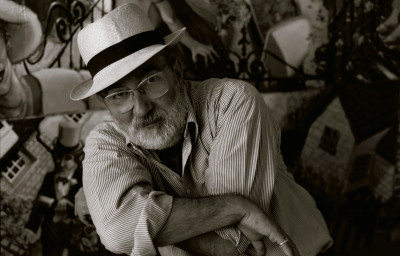Remembering Robert Clatworthy
Remembering Robert Clatworthy
By Christopher Le Brun PRA, on behalf of the Royal Academy
Published 24 March 2015
A key figure in a group of sculptors who emerged in the 1950s, we look back on the career of Robert Clatworthy, who has passed away aged 87.
-
Rising to prominence alongside Eduardo Paolozzi, Alberto Giacometti and Elizabeth Frink, Robert Clatworthy’s work was described by the art critic David Sylvester as “the best thing I have seen by any English sculptor younger than Henry Moore.”
Best known as an animal sculptor, much of Clatworthy’s early work consisted of vigorously modelled bulls, cats and horses and his unique impressionistic style explored a middle ground between the figurative and the abstract. Unlike Giacometti and Frink, who worked slowly in dry plaster or clay, Robert worked rapidly in quick-drying wet plaster to instil his animals with energy and vitality.
-

Robert Clatworthy RA, Horse and Rider, 1955.

Robert Clatworthy RA, Bull, 1955.

Robert Clatworthy RA, Bull IV, 1953.

Robert Clatworthy RA, Cat, 1954.

Robert Clatworthy RA, Horse and Rider I, 1954.

Robert Clatworthy, Bull, 1957.

Robert Clatworthy RA, Cat, 1973.

Robert Clatworthy RA, Head III, 1990.
-
-
Born on 31 January 1928 in Bridgwater, Somerset, Robert began his studies at the West of England College of Art. His training was interrupted by a period of National Service, after which he joined Chelsea School of Art in 1949 and spent a year at the Slade in 1951. In 1956 he became a member of the London Group, which had been created in 1913 to offer additional exhibiting opportunities to artists besides the Royal Academy of Arts.On leaving the Slade, Robert had his first solo show at the Hanover Gallery, followed by another alongside artists such as Giacometti, Germaine Richier, César, Francis Bacon and Picasso, in 1957. By this time, Robert’s frenzied animals had made him one of the best-known sculptors in Britain. The first of two bronze bulls was acquired by Tate shortly after the exhibition – one of a series of studies for a life-size bull commissioned by London County Council. It is now a listed public sculpture (above) standing in Roehampton’s Alton Estate in South West London.
Later, his sculptures became increasingly abstract, loosely inspired by the human figure (right). They remain among his most original pieces.
Robert also had a varied teaching career both at the Royal College of Art and the West of England College of Art in the 1960s and early 1970s. In 1972 he was among those who exhibited at the Royal Academy’s British Sculptors ’72 exhibition, and was elected a Royal Academician the following year. He exhibited at the RA many times over the following decades.
In the 1990s, Robert’s painterly approach to sculpture stood him in good stead when he developed a skin condition as an allergic reaction to plaster and had to give up sculpting. He started painting largely heads and nudes, which were always artworks in their own right and never studies for sculpture.
Robert’s work is now held in the collections of the Arts Council, Tate, the Victoria & Albert Museum and the RA, and a retrospective book on his sculpture and drawings was published in 2012.
Although in later life he became increasingly reclusive, living with his second wife Jane on a remote farm in Wales, he continued to work until the end of his life. Robert preferred not to talk about his art, saying “it must stand on its own without the need of words to support it.”
Robert died peacefully on 16 March aged 87.

-












